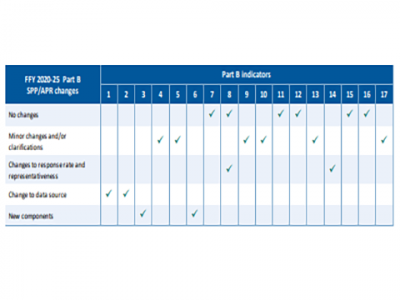
Resource Library
Guides. Briefs. Toolkits. Quick reference information. IDC and its partners created these data quality resources to help states better prepare to address their existing or emerging IDEA data quality needs. Use our search and filtering tools to navigate the library.
Resources 50 - 56 of 88
Format: Guides and Briefs
FFY 2020–25 Part B SPP/APR Changes at a GlanceThe FFY 2020–25 Part B SPP/APR Changes at a Glance resource is a quick overview for tracking updates to indicators in the new FFY 2020–25 SPP/APR package. For each of the 17 SPP/APR indicators, the table denotes whether there will be no changes, minor changes and/or clarifications, changes to response rates and representativeness, changes to data sources, and new components.
Format: Quick Reference
Frequently Used Terms and AcronymsDo you confuse your OMB MAX for your EMAPS? Has your SLDS slid into your SSIP? If so, this list is for you. Keep the alphabet soup organized with our handy Frequently Used Acronyms and Terms resource, downloadable for your convenience.
Format: Quick Reference
Due Dates for SY 2022-23 IDEA DataIDC updates this list of EDFacts Submission System (ESS) files and EMAPS submissions due dates for SY 2022-23 so you don't have to! Download it and pin it to your refrigerator where it'll help you stay cool.
Format: Quick Reference
618 Data Collection and Submission TimelineA graphic illustrating how different IDEA data collections can span multiple years and how a state may be working simultaneously with data from multiple school years.
Format: Toolkits
LEA Data Processes ToolkitThere is a continuous need for state education agencies (SEAs) and local education agencies (LEAs) to collect and report comprehensive, high-quality data and ensure they report data accurately and in a timely fashion. The customizable IDC LEA Data Processes Toolkit is a new instrument that can improve decisionmaking about children and youth with disabilities by ensuring data are of high quality and processes are clearly defined and documented, while also providing data staff a map for documenting data processes within local districts.
Format: Applications and Spreadsheets
IDEA Part B Data Manager CompetenciesThe IDEA Part B Data Manager Competencies tool outlines foundational knowledge and skills necessary for typical data manager roles and responsibilities. The competencies reflect principles for effective management, support, and use of high-quality IDEA Part B data and fall under one of three overarching categories: content knowledge and skills, technical knowledge and skills, and interpersonal skills.
Format: Guides and Briefs
The Assessment Data Journey: Are We There Yet?Data for Part B Indicator 3 follow a long and complicated process that begins when a student is registered as a test taker in a state assessment system and ends with public reporting via the SPP/APR. Multiple factors are involved in this process, and regular and ongoing communication and collaboration among the various people involved can make this process easier. This suite of four resources can help states with the work. The interactive infographic provides general information about the process for a typical state.








